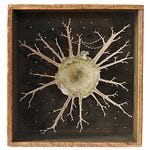
Here’s an essay about learning to heal loneliness, offered to you as a Thank-You gift for reading, listening, and praying along with me during May. I feel so encouraged by your presence. May reflecting on respectful relationships bring insight and hope into your world.
The Museum of My Lonely Heart
by Marianne Abel-Lipschutz
My complicated history with stealing may have started on nature walks in grade school. Teachers taught us simple ways to study what we explored in our suburban Chicago town. Students made leaf collections, smearing Elmer’s white glue on the backs of dried leaves we’d picked up in the neighborhood to fill pages in autumn scrapbooks. One leaf per page with the tree’s name. There was no mention of maybe the leaves were needed by the soil or that they belonged to the land where they’d grown.
We killed butterflies and beetles, and organized them on quilting pins on a whiteboard. We printed each insect’s name carefully before gluing the paper strips alongside each insect. Lightning bugs filled Mason jars for a few days. We threw them out after their lights dimmed. In a family of five, school projects weren’t kept long.
There was no talk of the torture of small creatures. Nature was just there. There for the taking.
No one mentioned that our parochial school was built on the traditional homelands of the Three Fires: the Ottawa, the Potawatomi, and the Ojibwa. We all lived on land stolen from Three Fires peoples when they were forced west against their will in 1835. Stealing is part of our history.
***
I stole money from people and things from Woolworth’s dime store downtown in fourth grade. I slipped a check out of a lady’s pocketbook at church one Sunday, then forged it for cash at the local movie theater later that week. After buying popcorn and Raisinets for the matinee, I set most of the money aside to donate to the mission fundraising competition at our Catholic grade school. I really wanted our class to win and be cheered when the money thermometer filled up with Maybelline red paint.
Beyond seeking the approval of the nuns, I couldn’t say exactly why I engaged in stealing. Psychology suggests I wanted to draw attention to our family’s need for attention. Ours was a good-enough family but we kept secrets about serious problems.
Eventually, a police officer knocked on our front door and inquired about the forged check. I confessed and agreed to apologize to the lady at her house with my dad. He offered her cash restitution, money I had to pay off through chores. Sadly, the silence about domestic violence at home persisted along with my shame.
My stealing habits shifted to other pursuits. Some Saturdays I’d borrow a grocery cart from the local Kroger’s store and wander the trails of Panfish Park for the afternoon, walking the cart as if it were a companion. I’d return it to the rack in the parking lot on my way home. I wish someone had taught me that the woodland preserve itself was another support, an important companion in a lonely time.
Stealing is acting on the impulse to take something for my use or pleasure that doesn’t belong to me. It’s as true in a store or a library or someone else’s home as it is in a forest or along the shoreline where a mussel’s abalone glints in the sunlight and, delighted with this beachfront trinket, I transfer it into my pocket and off we go. Of course, I don’t think of that as stealing but I should.
Loneliness is a common human feeling when social attachments fade and interpersonal connections diminish in value. Different from solitude or being alone, loneliness can motivate me to connect with something or someone outside my boundaries. In the past, that yearning to be in a relationship could be satisfied by stealing. Disordered feelings still urge me to take what isn't mine but my self-restraint is stronger now. I’ve learned to feel content without needing to possess more.
***
I treasure all manner of stolen objects, plucked without permission from environments where I once felt connected so tenderly that I didn’t want to live without their charm. I cradle each item into my surroundings.
Wherever I’ve moved, I’ve carried shells and pottery shards and leaves and beaver-toothed shreds of oak and seed pods and a hunk of coal--even a tiny bird nest half the size of this paragraph that was blown out of a tree. Living with favorite things helps me attach to a new location where, before long, I’ll bring home new souvenirs from the beginnings of relationships that mark my settling in.
Tiny worlds fill the six-inch wide disk that holds up my nightstand lamp. Each object carries its own folklore--stories about its formation, mode of living, origins, and its history with me. There are two shells from Deer Isle, Maine, a favorite place shaped by ocean, wind, rock, and marine life: one conch and a snail decorated with barnacles.
There’s a quarter section of a broken sand dollar polished by the beach; is it from Florida? I forget. Rather than reading at night, I like to pick up a third, finger-tip size snail shell with a fabulous Fibonacci spiral and marvel at its elaborate patterning.
No, wait. I picked up that chipped sand dollar on the bright sand outside Corpus Christi, Texas, when I visited my brother James two years ago.
Six years ago I added a chunk of dolomitic limestone to the nightstand. I noticed the rock in the construction backfill behind my brother Steve’s old house in suburban Washington D. C. where I’d wandered in the woods after his funeral, inconsolable and bereft at his unexpected death. We had no history with dolomitic limestone or construction backfill.
Why this rock would forever remind me of my brother is a mystery and a testament to the possibilities of meaning-making with nature. I view it now the same way I saw it that afternoon: chalk white, hard, devoid of darkness. A palm-size gravestone.
The nightstand itself is a (stolen) found object: a three-foot wide polished marble circle balanced atop a dark wooden base with shapely Victorian legs taken from an abandoned mansion on Rittenhouse Square in Philadelphia in 1972 with my boyfriend at the time. Who knows the origin of the marble tabletop?
And what are these things doing in my bedroom now, half a century and half the country away from where I picked them up?
Yes, a lost house itself is a tragedy, but there is an entire universe in the items inside, an entire universe in the single page of a book that drifts away while you’re running to catch a flight. There is an entire universe in a quote, an entire universe in interpretations of a book that begs for humanity to find a way to survive when our environment cannot sustain us anymore. In lieu of words, do not send invented photos or videos that supposedly say something profound. I would prefer silence. I would prefer a room where I can sit with someone who holds in their hands something they saved from the end of the world this time, something that reminds them of someone else. ~Hanif Abdurraqib*
I imagine that the popular slogan, “Take Only Photos. Leave Only Footprints” was a hard sell when it emerged as an awareness campaign for responsible partnership with nature decades ago. Yet through such educational projects, the self-centered practices of littering and taking things without permission have evolved.
Indigenous ways of requesting permission to forage or hunt teach us the common courtesy of belonging: we ought to seek permission from the property owner as well as from the animals and plants themselves. The USDA distributes pamphlets endorsed by indigenous herbalists instructing readers how to conduct honorable harvests and grant respect to all living things.
The mutuality implied by seeking consent is valued now as a moral concept and a spiritual practice that can lead to solutions for our loneliness. Granting consent opens a relationship--whether between us and the divine, the created world, or the people we choose. Acknowledging our dependence on one another is as critical as recognizing that we all have gifts to give.
New principles for seeking reparation and restitution for past harms elaborate on these profound interactions. Seeking a truce or brokering a treaty don’t end the cycle. Museums are returning objects collected through the centuries and brought to foreign places for an adult’s version of “Show and Tell” after colonists, explorers, and conquerors took what didn’t belong to them and brought it all back home.
We can witness the difficult repatriation of stolen goods, paintings, and possessions from the Nazi era being restored to their rightful owners. Descendant communities are regaining title to their traditional homelands in many countries. The bones of deceased peoples are being returned to the soil from which they grew in sacred burial rights long denied.
Truth and reconciliation commissions foster the agonizing heart work of restoring stolen souls and vandalized countries damaged by hatred, racism, rape, and war.
Putting things back where they came from is not always possible.
Nature is there for the taking, but it is also there for the tending.
I choose to unlearn the antisocial habits of my youth by resolving my needs in healthier ways. My parents’ plan to secure my confession and give restitution to the church lady I harmed were sound principles of reconciliation for the incident of forging that check in fourth grade.
Broken people are restored to community through grace and forgiveness. I need that mercy now in reconciling my human nature through redemptive relationships in my walk through this world.













Share this post